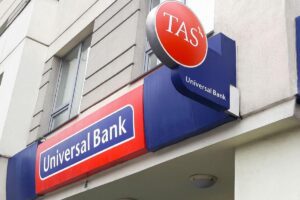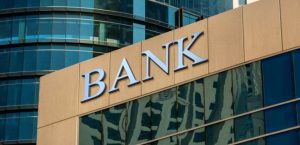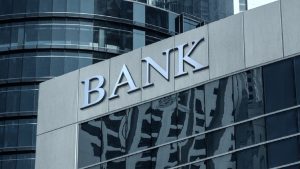
The net profit of Universal Bank (Kyiv) in January-June 2021 amounted to UAH 1.65 billion, which is 5.7 times more than in the same period of 2020 (UAH 288.614 million).
According to the quarterly reports published on the bank’s website, its net profit for the second quarter of 2021 amounted to UAH 782.255 million, which is 6.3 times more than in the corresponding period last year (UAH 123.96 million).
The bank’s net interest income for the six months increased by 2.2 times compared to the same period in 2020, to UAH 2.2 billion, and net commission income – by 1.5 times, to UAH 1.25 billion.
The bank’s assets in January-June increased by 23.2%, to UAH 41.859 billion, including loans and customer debt – by 1.3 times, to UAH 22.19 billion, and cash and cash equivalents – by 8%, to UAH 4.49 billion.
Universal Bank’s liabilities for the first half of the year increased by 20%, to UAH 37.5 billion, including customer funds – by 18.8%, to UAH 32.526 billion.
The bank’s equity capital in January-June grew by 1.6 times, to UAH 4.3 billion, while the charter capital remained at the level of UAH 4.309 billion.
Universal Bank is part of TAS Group of businessman Sergiy Tigipko, which was founded in 1998 and has assets in financial and industrial sectors, agriculture, real estate, pharmaceuticals and venture projects. In addition to Universal Bank, the financial sector of the group includes TAScombank, two insurance companies, and a number of other organizations.
According to the National Bank of Ukraine, as of June 1, 2021, Universal Bank ranked 11th in terms of total assets (UAH 42.96 billion) among 73 banks operating in the country.

The solvent banks of Ukraine in January-February 2021 received UAH 6.491 billion of net profit, which is 2.5 times less than in the same period of 2020 (UAH 15.877 billion), according to data published on the website of the National Bank of Ukraine (NBU).
According to the data, the income of banks for the two months of this year decreased by 1.3 times against the indicator for the same period last year, to UAH 35.089 billion. In particular, the result from revaluation and from sales and purchases was negative and amounted to UAH 3.856 billion, while in the same period last year it was positive and amounted to UAH 7.865 billion.
At the same time, commission income grew by 15.9%, to UAH 12.379 billion
The expenses of the banking system in January-February 2021 decreased by 5.8% compared to this indicator in 2020, to UAH 28.598 billion, in particular, payments to reserves by 21.9%, to UAH 1.048 billion. At the same time, commission expenses increased by 26.5%, to UAH 4.715 billion.
As reported, Ukrainian banks in 2020 reduced their net profit by 29%, to UAH 41.3 billion, but in the fourth quarter the decline was 63% due to increased payments to reserves.

Polish Getin Holding S.A. (Wroclaw) on February 5 signed an agreement with a Ukrainian buyer for the sale of 100% of the shares of subsidiary Idea Bank (Lviv) and 100% of the shares of New Finance Service (Kyiv), Getin Holding S.A. has said.
According to a report on biznes.pap.pl, the parties plan to close the potential deal by September 30, 2021.
Before that the buyer will conduct due diligence the companies, and after a positive result of the due diligence the parties will proceed to agree on the terms of the potential transaction.
Getin Holding also reports that the company granted the buyer exclusive rights for negotiations until April 30, 2021.
Idea Bank (formerly Plus Bank) was founded in 1989. As of January 1, 2020, its sole shareholder was the financial group Getin Holding S.A. (Poland).
According to the National Bank of Ukraine, as of October 1, 2020, Idea Bank ranked 24th among 74 operating banks in terms of total assets (UAH 8.057 billion).

Ukrainian banks in 2020 reduced the number of structural divisions by 10.8%, or by 868 branches, to 7,134.
According to the data posted on the website of the National Bank of Ukraine (NBU), by the end of 2020 Oschadbank closed the operation of 490 branches (having reduced their number to 1,837), PrivatBank – 211 (to 1,717), Raiffeisen Bank Aval – 100 (to 396), Alfa-Bank – 39 (to 218), TAScombank and Sberbank – 16 each (to 87 and 90 respectively), UkrSibbank – 12 (to 272), Credit Dnipro Bank and PIB – eight (to 28 and 26, respectively) and Ukrbudinvestbank – seven (to 48).
It is indicated that in October-December 2020, banks closed 195 structural divisions, in particular Oschadbank – 94, Raiffeisen Bank Aval – 60, PrivatBank – 33.
At the same time, banks opened 79 branches in 2020, in particular state-owned Ukrgasbank – 26 divisions, expanding its regional network to 276 branches, Accordbank – eight (to 79), Bank Sich – six (to 60), FUIB – 16 (to 224), A-Bank – seven (to 232), and Bank Alliance – five (to 25).
According to the National Bank, as of January 1, 2021, Oschadbank remains the leader in the number of branches (1,837), PrivatBank ranks second (1,717), Raiffeisen Bank Aval is third (396), Ukrgasbank is fourth (276), and UkrSibbank ranks fifth (272).

The single counterparty exposure limit (H7, should be no more than 25%) as of December 1 was violated by Prominvestbank (84.03%), Industrialbank (82.88%), Sberbank (53.13%) and Misto Bank (39.21%), according to the website of the National Bank of Ukraine (NBU).
According to the regulator, the related party transactions exposure limit (H9, should not exceed 25%) was violated by Megabank (37.56%), First Investment Bank (52.6%) and Unex Bank (29.21%).
The limit on bank total long open FX position (L13-1, should be no more than 10%) was violated by Prominvestbank (133.41%), Oschadbank (119.97%), PrivatBank (98.27%) and Industrialbank (13.15%).
The limit on bank total short open FX position (L13-2, should be no more than 10%) was violated by Prominvestbank (167.35%).
Misto Bank, recognized by the NBU as insolvent, violated the short-term liquidity ratio (H6, at least 60%), which amounted to 44.36%.

The fall of the Ukrainian economy in 2020 may amount to 5.5% of GDP with a further recovery of growth by 3.5-4% in the next two years, analysts at Deutsche Bank expect.
According to the materials of Emerging Markets Outlook 2021, experts admit that the next tranche of the International Monetary Fund (IMF) will be allocated to Ukraine in early 2021, which will pave the way for obtaining funding from other international partners.
At the same time, the central bank will leave the discount rate at 6% per annum, according to the review.